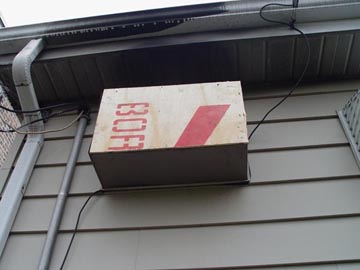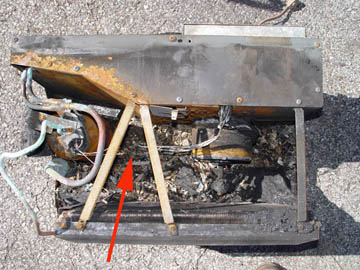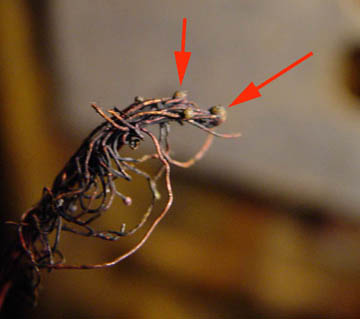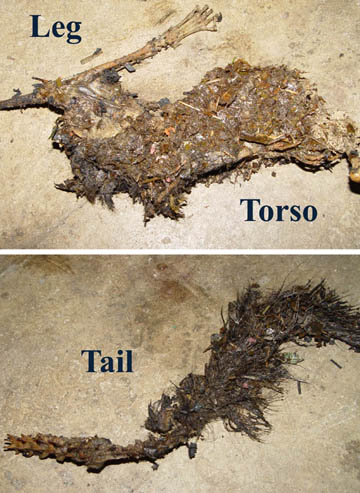
Figure 1
the subrogation potential of such a loss, a fire investigation as to the cause is prudent. It was winter and the
unit had been turned off, but not disconnected from the
home wall receptacle. The protective cover around the
outside of the air conditioning unit had been removed
by the insured prior to the fire. There was severe fire
damage to mechanical and electrical components. Inspection of control wiring showed no evidence of malfunctions.

Figure 2

Figure 3
While investigating the fan cavity in the unit, faulted
wiring was noted as indicated by the red arrow in Figure 2.
Figure 3 is a view of the faulted wiring showing beading on several of the wire strands. The circuit breaker
had tripped, but sufficient heating from the fault had
developed to ignite what appeared to be combustible
material in the air conditioning unit. But, wait a minute, what is combustible material doing in the air conditioning unit? Excavation through the material, which
was a mish mash of sticks, leaves and grass, resulted in
discovery of the skeletal remains of a rodent-like animal
(Figure 4). Examination of the carcass suggested it

Figure 4
was that of a North American grey squirrel. The significance of this find must be factored into the assessment
of whether a defect in wiring caused the fire, or some
intervening cause (the squirrel). The faulted wiring is
not near a sharp bend or other chafing surface (Reference 1)
that could have caused insulation breakdown. Since the unit
was not operating at the time of the fire, vibratory influences on chafing of wire insulation are, most likely,
not a factor. The combustible material was obviously a
nest that the biologic (squirrel) used to pad its new digs.
Normally, when rodents smell smoke, their instinct tells
them to leave the scene. This one did not make it out in
time, suggesting it was incapacitated, possibly by electrocution. It is known that rodents chew on wire insulation for a variety of reasons.(Reference 2) The suggestion
that the squirrel chewed through wiring, causing an electrical
fault and fire could not be ruled out. The preponderance
of the evidence suggests that intervention by the biologic is more likely the cause of the fire than defective
design or manufacture of the air conditioner. Since the
biologic does not have legal standing (at this time),
subrogation potential and chance of recovery are considered poor.
References:
1. Roberts, Charles C. Jr., “Wire Chafing, a Cause of
Electrical Fires,” Claims Magazine, April 1999, p79-80.
2. Roberts, Charles C. Jr., “Rodent Damage to Automobiles,” Claims Magazine, December 1996, p 35-36.
BACK TO C. ROBERTS CONSULTING ENGINEERS HOME PAGE,
WWW.CROBERTS.COM

Figure 2

Figure 3

Figure 4
was that of a North American grey squirrel. The significance of this find must be factored into the assessment
of whether a defect in wiring caused the fire, or some
intervening cause (the squirrel). The faulted wiring is
not near a sharp bend or other chafing surface (Reference 1)
that could have caused insulation breakdown. Since the unit
was not operating at the time of the fire, vibratory influences on chafing of wire insulation are, most likely,
not a factor. The combustible material was obviously a
nest that the biologic (squirrel) used to pad its new digs.
Normally, when rodents smell smoke, their instinct tells
them to leave the scene. This one did not make it out in
time, suggesting it was incapacitated, possibly by electrocution. It is known that rodents chew on wire insulation for a variety of reasons.(Reference 2) The suggestion
that the squirrel chewed through wiring, causing an electrical
fault and fire could not be ruled out. The preponderance
of the evidence suggests that intervention by the biologic is more likely the cause of the fire than defective
design or manufacture of the air conditioner. Since the
biologic does not have legal standing (at this time),
subrogation potential and chance of recovery are considered poor.
References:
1. Roberts, Charles C. Jr., “Wire Chafing, a Cause of
Electrical Fires,” Claims Magazine, April 1999, p79-80.
2. Roberts, Charles C. Jr., “Rodent Damage to Automobiles,” Claims Magazine, December 1996, p 35-36.
BACK TO C. ROBERTS CONSULTING ENGINEERS HOME PAGE,
WWW.CROBERTS.COM
BACK TO C. ROBERTS CONSULTING ENGINEERS HOME PAGE,
WWW.CROBERTS.COM
WWW.CROBERTS.COM